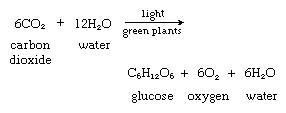
Photosynthesis is the process by which green plants and certain other organisms transform light energy into chemical energy. Photosynthesis in green plants harnesses the energy of sunlight to convert carbon dioxide, water, and minerals into organic compounds and gaseous oxygen.
In addition to the green plants, photosynthetic organisms include certain protists (such as euglenoids and diatoms), cyanophytes (blue-green algae), and various bacteria. The process in photosynthetic protists and cyanophytes resembles that in green plants; it differs in the photosynthetic bacteria in that compounds other than water serve as a reactant and oxygen is not produced. All photosynthetic organisms--with the exception of a minor group of bacteria, the halobacteria--contain the light-absorbing pigment chlorophyll, which plays a key role in the transfer of energy from light to chemical compounds.
Photosynthesis is the fundamental process that maintains life on Earth. Living cells convert food into energy and structural components. Almost all organisms derive this food, directly or indirectly, from the organic compounds formed within plants during photosynthesis. The stored energy in these compounds is essential for growth, repair, reproduction, movement, and other vital functions. Without photosynthesis, not only would replenishment of the fundamental food supply halt but the Earth would eventually become devoid of oxygen.
Just as the organic molecules in the bodies of living organisms contain energy converted by photosynthesis from the energy of the Sun, so do the molecules of fossil fuels. The energy provided by coal, oil, and gas comes from photosynthesis carried on by plants of earlier times and preserved down through the ages, to be released by combustion in modern industrial processes. Most of the energy released both by the burning of fossil fuels and by the metabolism of living cells is given off as heat and must be replaced by the continued input of radiant energy from the Sun.
The principal organic products of plant photosynthesis are carbohydrates. Formation of the simple carbohydrate glucose is shown by the equation

The molecules of glucose produced are usually linked with other molecules to form more complex carbohydrates. Other products of photosynthesis are formed by incorporating mineral elements into the process. The energy required to break the chemical bonds in the reactants and to create new bonds in the products is provided by light. The excess energy not used up in the chemical reactions is stored as chemical energy in the organic products formed.
The rate of photosynthesis is dependent on the following environmental factors: light intensity, temperature, and the availability of carbon dioxide, water, and certain minerals. A shortage of any one of these factors can limit the rate of photosynthesis, and an increase in the particular rate-limiting factor will, up to a point, speed up the process. The rate also varies with the plant species and its physiological state.
Photosynthesis is not a single process but consists of a number of photochemical and enzymatic reactions. In green plants, the intricate apparatus required for such complex processes is located in the chloroplasts, the cell organelles that contain the chlorophyll. The chloroplasts are crowded with multiple layers of membranes, the lamellae, composed of proteins and lipids. The protein matter includes some of the enzymes and coenzymes used in the photosynthetic process; the lipid portion contains two types of chlorophyll, along with other pigments that assist in absorbing light energy.
Excerpt from the Encyclopedia Britannica without permission.